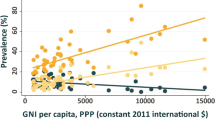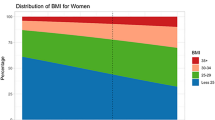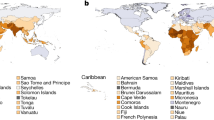Abstract
Objectives: The key objective was to estimate obesity (≥30 kg/m2) in women 15–49 y from developing countries. A second objective was to study how obesity varies by educational level and by residence in urban and rural areas. A third objective was to investigate how national incomes shape the relationship between obesity and eduction or residence.
Design: The analyses use cross-sectional data from nationally representative surveys from developing countries carried out in the last decade. Most of the surveys were Demographic Health Surveys (DHS). Data from a survey from the USA are used for comparison.
Setting:The 39 surveys used come from 38 developing countries and the USA.
Subjects: A total of 147, 938 non-pregnant women 15–49 y were included in the analyses.
Results: The percentage of obese women was 0.1% in South Asia, 2.5% in Sub-Saharan Africa, 9.6% in Latin America and the Caribbean, 15.4% in Central Eastern Europe/Commonwealth of Independent States (CEE/CIS), 17.2% in the Middle East and North Africa, and 20.7% in the USA. Levels of obesity in countries increased sharply until a gross national product of US$1500 per capita (1992 values) was reached and changed little thereafter. In very poor countries, such as in Sub-Saharan Africa, obesity levels were greatly concentrated among urban and higher educated women. In more developed countries, such as those in Latin America and the CEE/CIS regions, obesity levels were more equally distributed in the general population.
Conclusions: Based on the analyses presented and on a review of the literature, it is concluded that obesity among women is a serious problem in Latin America and the Caribbean, the Middle East and North Africa, and the CEE/CIS region. Obesity is less of a concern in Sub-Saharan Africa, China and South Asia. Obesity levels increased over time in most of the limited number of countries with data, but at varying rates. Rising national incomes in developing countries and increased ‘Westernization’ will most likely lead to increased levels of obesity in the future.
Sponsorship: Financial support was provided by the Food and Nutrition Program of the Pan American Health Organization and by the World Bank.
European Journal of Clinical Nutrition (2000) 54, 247–252
This is a preview of subscription content, access via your institution
Access options
Subscribe to this journal
Receive 12 print issues and online access
$259.00 per year
only $21.58 per issue
Buy this article
- Purchase on Springer Link
- Instant access to full article PDF
Prices may be subject to local taxes which are calculated during checkout
Similar content being viewed by others
Author information
Authors and Affiliations
Contributions
Guarantor: R Martorell
Corresponding author
Rights and permissions
About this article
Cite this article
Martorell, R., Kettel Khan, L., Hughes, M. et al. Obesity in women from developing countries. Eur J Clin Nutr 54, 247–252 (2000). https://doi.org/10.1038/sj.ejcn.1600931
Received:
Revised:
Accepted:
Published:
Issue Date:
DOI: https://doi.org/10.1038/sj.ejcn.1600931
Keywords
This article is cited by
-
Predicting the effect of sulfadoxine-pyrimethamine uptake by pregnant women on birth weight using a generalized ordered partial proportional odds model
BMC Pregnancy and Childbirth (2022)
-
Identification of a novel ESR1 mutation in a Chinese PCOS woman with estrogen insensitivity in IVF treatment
Reproductive Biology and Endocrinology (2022)
-
Eating behaviors, attitudes, and beliefs that contribute to overweight and obesity among women in Lilongwe City, Malawi: a qualitative study
BMC Women's Health (2022)
-
Zero malaria: a mirage or reality for populations of sub-Saharan Africa in health transition
Malaria Journal (2022)
-
Aerobic Exercise and Resistance Training to Improve Sexual Health and Emotional Problems of Obese Women
Trends in Psychology (2022)



